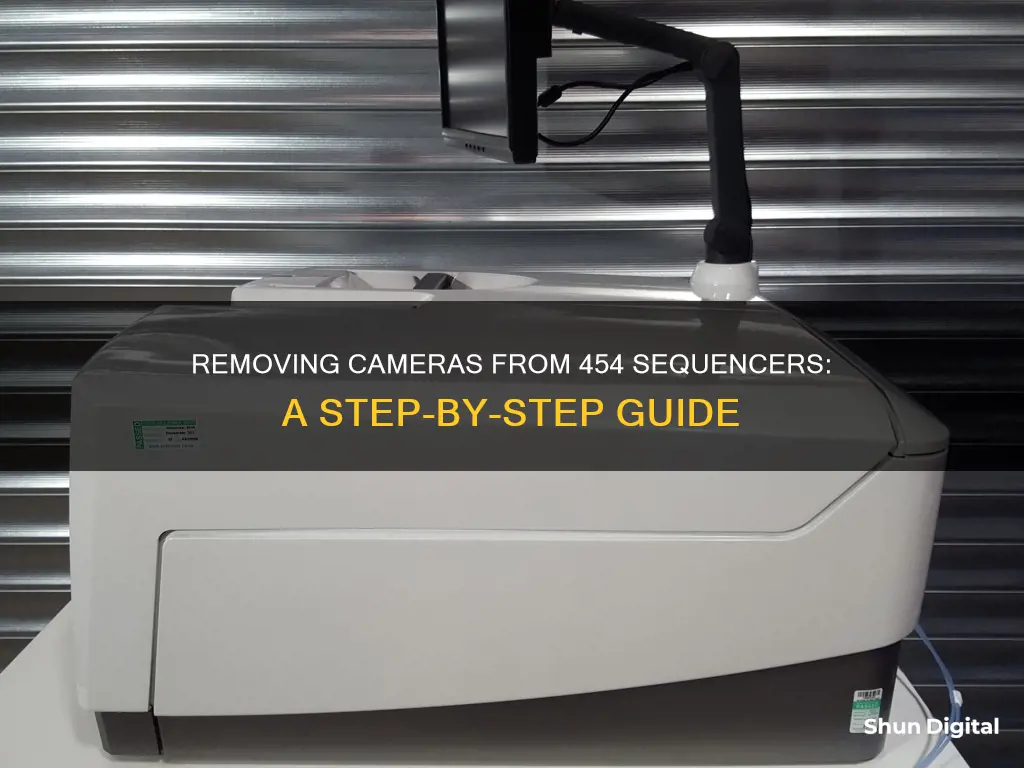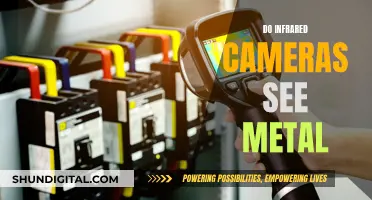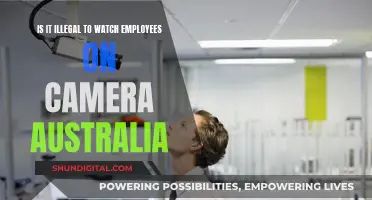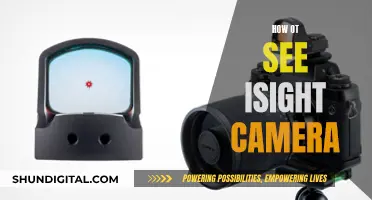
The 454 sequencer is a DNA sequencing machine that uses pyro-sequencing to sequence DNA fragments. The process involves fixing DNA fragments to small DNA-capture beads in a water-in-oil emulsion and amplifying them through PCR. The beads are then placed into a PicoTiterPlate, a fibre optic chip, along with a mix of enzymes. The PicoTiterPlate is then placed into the 454 sequencer for sequencing. During the sequencing run, the camera in the instrument records light signals that are emitted when a complementary nucleotide is added to a well in the PicoTiterPlate. This light is recorded by a camera in the instrument, which can then be removed and repurposed for other uses such as astro-photography or particle detection.
What You'll Learn

The camera's function in the 454 sequencer
The 454 sequencer is a next-generation DNA sequencer that uses pyrosequencing to sequence DNA fragments. This process involves the emission of light when nucleotide bases are incorporated into the DNA. The camera in the 454 sequencer plays a crucial role in capturing and recording this light emission.
The camera is sensitive and designed to detect photon emissions resulting from the presence or absence of a sequential associated nucleic acid. This data is then used to generate sequences from DNA fragments. The camera's function is integral to the sequencing process, as it captures the light signals that indicate the incorporation of nucleotide bases.
The camera's function is not limited to simply capturing images. It also plays a role in the initial setup and calibration of the 454 sequencer. During the firing-up process, the camera needs to be fully operational for the instrument to function correctly. The camera's cooling mechanism, in particular, is crucial for optimal performance.
Additionally, the camera's optics and sensor play a significant role in the overall performance of the 454 sequencer. The sensor is designed to be thermally chilled and decoupled from the outside surface, ensuring optimal image capture. The optics include a packed fiber bundle array that sits in front of the sensor, which helps to direct light signals onto the sensor for capture.
Is Your Camera Hacked? Here's How to Find Out
You may want to see also

Steps to remove the camera
The following steps outline the process of removing the camera from a 454 sequencer:
Step 1: Pre-Disassembly
Before beginning the disassembly process, it is important to ensure that the 454 sequencer is powered off and unplugged from any power sources. This will help ensure your safety and prevent any potential damage to the device.
Step 2: Accessing the Camera
The camera is located within the imaging hardware block, which is integrated into the machine. To access the camera, you will need to remove the handle and any associated cover hardware. This may involve prying and unscrewing some allen screws.
Step 3: Disconnecting the Camera
Once you have accessed the camera, you will need to disconnect it from the rest of the device. The camera is connected by a quad rs-422 bus and a round twist-lock connector for power. Carefully disconnect these cables to free the camera from the rest of the sequencer.
Step 4: Removing the Cooling System
The camera in the 454 sequencer requires a dedicated cooling system to maintain optimal temperatures. To fully remove the camera, you will need to detach the cooling system, which includes a fan and a peltier junction. Take note of how the cooling system is connected so that you can properly reinstall it if needed.
Step 5: Extracting the Camera
With the cooling system detached, you can now carefully extract the camera from the sequencer. It is important to handle the camera with care and avoid touching any sensitive components, as static electricity or mishandling can damage the camera.
Step 6: Post-Removal Checks
Once the camera has been removed, inspect the camera and the sequencer for any signs of damage. Ensure that no cables or connectors were damaged during the removal process. If everything appears intact, you can now proceed to repurpose the camera for other applications or install a replacement camera if needed.
By following these steps, you can successfully remove the camera from a 454 sequencer. Remember to wear appropriate protective gear, especially when handling any biological components that the sequencer may have come into contact with.
Apple Watch: Camera Feature or Missing Component?
You may want to see also

Camera specifications
The camera in the 454 sequencer is a sensitive camera that looks for photon emissions and uses that data to generate sequences from DNA fragments. The camera is quite large and heavy, and is well-protected by a cast aluminium case. The camera has a few cables protruding from its back, and requires forced cooling to manage the thermal buildup on the back of the peltier junction. The camera is kept cool by a rubberised air guide, with a small slit to pass cables through. The camera is also thermally chilled and thermally decoupled from the outside surface, with a cast base and shock dampeners.
The camera is powered through a round twist-lock connector, and uses a quad rs-422 bus to transfer data over copper. The camera has a sensor that is viewed through a packed fibre bundle array. The sensor is in a vacuum and is chilled, with the fibre optic thermally decoupling the outside of the camera from the chilled vacuum-surrounded sensor.
The CCD camera records a light signal when a nucleotide complementary to the template strand is added to a well. The signal strength is proportional to the number of nucleotides added. The data is stored in standard flowgram format (SFF) files for downstream analysis.
Viewing Vivint Doorbell Camera Footage on Echo Spot Devices
You may want to see also

Re-purposing the camera
The 454 sequencer is a genome sequencer that uses pyro-sequencing to sequence DNA. The machine is built with a camera that is quite sensitive and fancy. The camera is used to look for photon emissions and generate sequences from DNA fragments. The camera is connected to the 454 sequencer through a 1U PC, which is an IBM X-Series 336 machine. The camera itself is quite large and has a number of cables protruding from its back. It requires forced cooling to keep the thermal buildup on the back of the peltier junction reasonable.
Now, let's talk about re-purposing the camera. Once the camera is removed from the 454 sequencer, it can be used for various other applications. Here are some ideas for re-purposing the camera:
- Astro-photography: The camera can be used for capturing images of celestial objects and phenomena. With its sensitivity and ability to detect photon emissions, it can be a powerful tool for astrophotography.
- Particle detectors: The camera can be utilised as a particle detector, capturing images of particles such as electrons, protons, and ions. This can be useful in scientific research and particle physics experiments.
- Charged particle imagers: The camera's ability to detect photon emissions can be leveraged to create charged particle images. This application can be valuable in fields such as physics, chemistry, and materials science.
- Scientific research: The camera can be a valuable tool for scientists in various fields, including biology, chemistry, and physics. It can be used for capturing images and gathering data in experiments and research studies.
- Surveillance: The camera can be repurposed for surveillance purposes, either for security or for observing wildlife and natural phenomena. Its sensitivity to light can be advantageous in low-light conditions.
- Art and creativity: The camera can be used for creative endeavours, such as experimental photography, light painting, or even as a prop in artistic installations.
When repurposing the camera, it is important to consider the camera's specific capabilities, such as its sensitivity to light and photon emissions. By matching the camera's strengths with the requirements of different applications, you can find unique and valuable ways to repurpose it. Additionally, don't forget to ensure that you have the necessary hardware and software to operate the camera independently from the 454 sequencer. This may include appropriate power sources, control software, and data processing tools.
Live Camera Streams: My Personal Data Was Exposed
You may want to see also

Post-camera removal maintenance
Once the camera has been removed from the 454 sequencer, there are several maintenance steps that need to be followed to ensure the continued functioning of the equipment. Here are some detailed instructions for post-camera removal maintenance:
Cleaning and Protection:
- It is important to wear protective gear, such as gloves, when handling the equipment as it may have been in contact with biological substances.
- Clean all surfaces and components that were exposed during the camera removal process. Use appropriate cleaning solutions and materials to ensure that any residual substances are removed.
- Inspect the equipment for any signs of damage or wear, especially around the areas where the camera was connected.
Electronics and Connections:
- Inspect all electronic components and connections to ensure they are secure and functional. Refer to the 454 sequencer's electronics guide for specific information on the Raspberry Pi HATs and other electronic components.
- Check the LED voltage settings and adjust them if necessary, following the instructions provided in the electronics guide.
- Verify that the external trigger functionality is correctly wired into a GPIO pin on the Pi, according to the instructions for your specific camera model.
Software and Controls:
- Ensure that the main control software is accessible and functioning properly. You may need to refer to the instrument's manual for specific instructions on operating the software.
- Test the camera cooling functionality and make any necessary adjustments to ensure optimal performance.
- If you encounter any issues with the software or controls, refer to the relevant manuals or seek technical support.
Hardware and Peripherals:
- Inspect and test any peripheral devices or hardware that were connected to the camera, such as the IBM server or other imaging hardware.
- Ensure that all hardware is securely mounted and that there is no loose wiring or connections.
- If you plan on reusing the camera for other purposes, refer to the section on "Re-purposing the Camera" for specific instructions and considerations.
By following these detailed maintenance steps, you can help ensure the continued functioning and performance of your 454 sequencer even after the camera removal process.
IR Camera Mist: How to See and Capture the Invisible
You may want to see also
Frequently asked questions
The 454 sequencer is a robust machine, so removing the camera will require some force. First, pry off the handle and cover hardware. Then, remove the fan rubber shroud—a curious design that includes cables protruding from the back of the camera. You will need to disconnect the camera's quad rs-422 bus and round twist-lock connector.
It is important to note that the 454 sequencer is a bio-contraption, so it is recommended to wear protective gear when handling the machine. Additionally, the camera has forced cooling, so you will need to account for the thermal buildup when removing the camera.
You can repurpose the camera for astro-photography, particle detectors, or charged particle imagers.
The 454 sequencer is a genome sequencer that uses pyro-sequencing to sequence DNA fragments. It was developed by 454 Life Sciences, a biotechnology company based in Branford, Connecticut, and later acquired by Roche.







